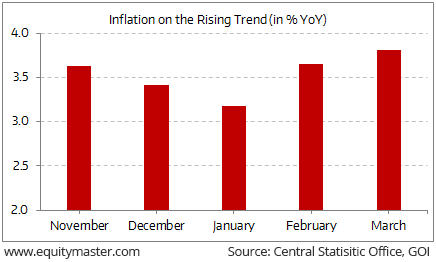India's Third Giant Leap
This Could be One of the Biggest Opportunities for Investors
- Home
- Todays Market
- Indian Stock Market News April 17, 2017
Sensex Trades Marginally Lower; Telecom Stocks Witness Selling Mon, 17 Apr 11:30 am
After opening the day on a flattish note, the Indian share markets witnessed choppy trades and are presently trading marginally lower. Sectoral indices are trading on a mixed note with stocks in the telecom sector and metal sector witnessing maximum selling pressure. Realty stocks are trading in the green.
The BSE Sensex is trading down 34 points (down 0.1%) and the NSE Nifty is trading down 10 points (down 0.1%). The BSE Mid Cap index is trading up by 0.1%, while the BSE Small Cap index is trading up by 0.3%. The rupee is trading at 64.38 to the US$.
In the news from the goods and services tax (GST) space, the government is now looking to bring variations in GST rates on the same types of products to a minimum.
This is to ensure that the GST structure does not get any more complicated.
Presently, India has adopted a four-tier tax structure of 5%, 12%, 18% and 28% under the GST regime for various products and services.
The rate applicable on most products is decided at 18%. The highest rate has been pegged in the GST law at 40%. Since there is a huge gap between these two rates, many believe the GST structure will undermine the basic tenet of being simple. And the above initiative is aimed at resolving this issue.
How the above development pan out remains to be seen.
We believe the implementation of the GST promises to transform India into a single common market and there are many sectors which stand to gain immensely from this transition.
Further, the Goods and Service Tax (GST) is likely to bring about a structural change in the Indian economy. The implementation of the same is bound to bring more companies under the new tax regime, thus providing a level playing field to organized players.
This could be a positive for stock market participants, as the above transition will lead to a value migration from unorganised players to organized players. And companies with solid fundamentals and a competitive moat will capture most of this value.
Apart from the above developments, market participants are also keeping tabs on the wholesale price-based inflation for March which the government is scheduled to release today.
The WPI inflation stood at 6.55% for the month of February 2017.
The release of March WPI inflation numbers will follow the recent announcement of retail inflation which rose to a five-month high of 3.81% in March. This was noted as the highest in five months, as can be seen in the chart below:
Retail Inflation Highest in Five Months
The above rise in retail inflation was seen on the back of higher fuel prices. Retail fuel inflation accelerated to 5.56% in March from 3.90% a month ago. Food prices rose 1.93% year on the year, slower than a 2.01% annual increase a month earlier.
The above data has vindicated the RBI's decision earlier this month to keep its policy rate on hold amid concern about rising prices.
It is important to note that the RBI gradually reduced the remonetisation pace in March, fearing a surge in CPI and WPI inflation due to pent-up demand after notebandi. The increase in currency being circulated was 5.9% week-on-week in January 13. It slowed to 4.6% in February 10, and further to 4% in March 10.
But what's the impact of rising inflation on stock returns? My colleague, Ankit Shah has written a brilliant piece on this subject. Here's a snippet:
- The government is spending a ton of money to boost rural consumption.
The RBI has indicated that it may be done with rate cuts.
As spending returns to normal after demonetisation, cash circulation in the economy will rise.
Early predictions of the monsoon are not very positive.
The trends point to a period of high inflation. Ideally, investors should be in stocks that can weather the storm.
But which stocks can deliver such returns during a period of high inflation?
For information on how to pick stocks that have the potential to deliver big returns, download our special report now!
Read the latest Market Commentary



Equitymaster requests your view! Post a comment on "Sensex Trades Marginally Lower; Telecom Stocks Witness Selling". Click here!
Comments are moderated by Equitymaster, in accordance with the Terms of Use, and may not appear
on this article until they have been reviewed and deemed appropriate for posting.
In the meantime, you may want to share this article with your friends!